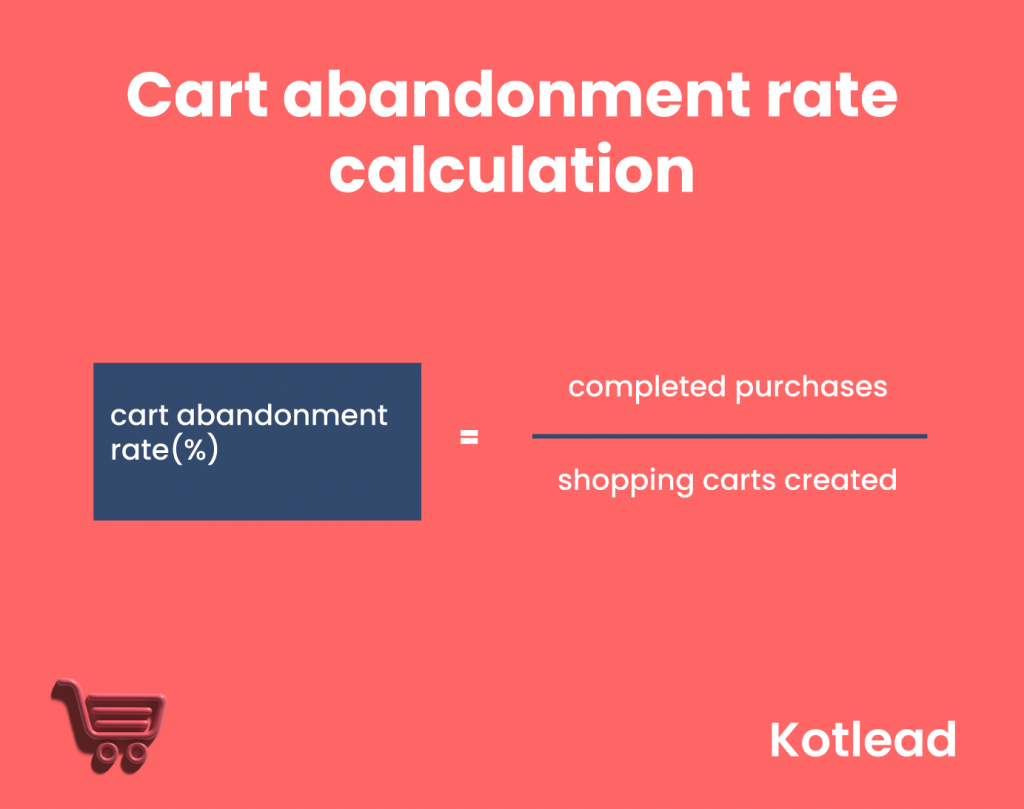Do you want to decrease shopping cart abandonment on your eCommerce website but don’t know where (or how) to begin?
I know that feeling… One of the most significant issues that online business owners deal with is shopping cart abandonment. To put this in a numerical perspective, out of every 10 customers who add an item to their cart, seven of them abandon it without making a purchase. Due to cart abandonment, e-commerce businesses lose $18 billion in sales income every year.
What is cart abandonment?
Cart abandonment is when a customer adds products to their cart but leaves the online store without paying. Cart abandonment may result from customers’ wistful window shopping, where they impulsively add products to their cart without really intending to buy them.
Additionally, customers may abandon their cart after experiencing friction during their online purchases. While the first happens frequently and cannot be prevented, the second can.
Some causes of cart abandonment
Cart abandonment may be very frustrating for retailers—customers have added things to their baskets, indicating a clear interest in their products, but something has kept them from making a purchase. Heads up, an interface that is difficult to navigate or a lengthy checkout process annoys customers and offers them time to reconsider their choices.
Prolonged or complex checkout procedures.
The optimal checkout process is fluid and effortless. This is the standard checkout procedure: Cart > Billing information > Shipping information > Shipping Method > Order Preview > Payment > Confirmation.
A checkout process that does not adhere to a logical order of steps can discourage customers, as that would require an excessive amount of information to complete the transaction, such as the customer’s phone number, date of birth, or gender.
Compulsory account creation.
Account creation requires more work, especially if they only want to make a one-time purchase. Consumers might not see the benefit. However, companies frequently require account creation in order to retarget clients with emails and increase lead generation.
First-time purchasers may be hesitant to provide their email addresses or enable the corporation to record their credit card information. From the perspective of the customer, opening an account entails remembering yet another password.
Delivery times exceeded expectations.
Some online retailers may not disclose an item’s estimated delivery date until the moment of purchase. Typically, delivery time is dependent on the location of the customer, especially for enterprises that ship internationally. Remember that acceptable delivery windows are decreasing. According to a poll of more than 1,000 U.S. consumers conducted by Alix Partners, consumers are ready to accept a maximum delivery time of 4.5 days, down from 5.5 days in 2012. However, this also depends on the thing in question. As they are built to order, custom products will inevitably require more time. Perishables and household items should be delivered swiftly to ensure food safety and because customers frequently place urgent orders for them. In comparison, delivery windows for durable goods such as furniture are somewhat more flexible.
Return and refund policy ambiguity
Due to the inability to see and touch the product prior to purchase, internet shoppers face a certain level of risk. Especially for expensive purchases, customers require assurance that they can obtain a refund or return the goods in the event of a problem or if the item is subpar. Providing a generous return policy or a longer return window instills confidence.
Insufficient payment options.
Due to increasing worries over data breaches and the ubiquity of contactless payment methods, customers seek diverse payment options. Apple Pay, Google Wallet, PayPal, and other digital wallets let people shop online without disclosing credit card information to merchants they may not trust. Through third-party suppliers such as Klarna, many internet retailers offer interest-free buy now, pay later (BNPL) services, which makes it easier for customers to finance larger purchases.
Problems with site speed and app performance.
People lose faith in your goods or service if your website’s interface is complicated or if it is slow. 75% of consumers, according to a Stanford research on web reputation, estimate the legitimacy of firms based on the design of their websites. Remember to increase your website’s uptime and accessibility in accordance with the holiday shopping season.
In addition, conduct cross-browser and cross-device tests to guarantee that your online store is compatible with all browsers and devices. You can discover reports on website performance across devices using Google Analytics: Audience > Technology > Browsers and Operating Systems or Audience > Mobile > Devices.
How to Determine the Shopping Cart Abandonment Rate

The Shopping Cart Abandonment Rate is derived by dividing the total number of completed purchases by the total number of created shopping carts. Subtract the result from one and then multiply by 100 to get the abandonment rate.
For instance, if you have 50 completed purchases and 200 shopping carts, your shopping cart abandonment rate is 75%.
1 – (50 / 200) = 0.75
Multiply by 100 = 75%
A few ideas for reducing cart abandonment.

Provide guest checkout alternatives.
Allow customers to bypass account creation if they so choose. This decreases the time required to complete a purchase by eliminating unnecessary procedures while allowing those who do not wish to give their personal information to do so with confidence.
Customers do not need to save their credit card information, and their email addresses will only be used for delivery updates if they opt for guest checkout.
Include clear calls to action
Nice, clear CTAs that aren’t deceptive generally pay off!
If shoppers are unsure about what to do next, they shouldn’t give up on their purchase. Ensure that the CTAs for each stage are distinct and employ standard language; avoid being innovative or cutesy. To commence the checkout process, the next call-to-action should be “Buy Now” after “Add to Cart.”
Provide a range of distribution options
When making purchases, customers frequently take shipping fees and delivery times into account. Therefore, be sure to offer choices that satisfy the requirements of your various clients. Do not display shipping costs to customers just before they are ready to complete their purchase. Delivery fees at the checkout may look to customers as “extra” fees, discouraging them.
Giving them a choice of delivery options keeps you flexible. Some clients may expect free or affordable delivery, while others may be more concerned with ease and quickness.
To suit a range of client preferences, sales sites should try to offer a number of delivery options.
Make a guest checkout available.
Customers ought to be given the option to forego creating accounts if they so desire. Making clients register and create accounts before allowing them to use the checkout process could prevent them from making a purchase.
When not absolutely essential, it makes prudent to get around this restriction and offer guests other checkout options.
Be Clear About Total Costs
Don’t surprise customers with extra taxes and fees at the checkout. They will believe they were duped. The discovery of “hidden” costs while paying for anything is a common reason for cart abandonment. When it comes to shipping, handling, and tax fees, be truthful. If feasible, include a range for shipping prices prior to checkout if you are unable to provide an exact figure (e.g., $2.99 to $3.99 for domestic delivery; $4.99 to $10.99 for international shipping).
Add status indications to the checkout page.
Progress bars are an excellent UI element since they inform users of the number of remaining stages in a user flow. This provides a sense of momentum that minimizes the possibility that a customer may abandon the checkout process due to its length.
An almost completed progress bar provides shoppers with visual encouragement to complete their purchases because they can see how much they have already committed in the checkout process. On your website, you may also incorporate a simple reminder or notification for the cart. For instance, if a consumer adds an item to their shopping cart but does not commence the checkout process, you can configure a pop-up to remind them that they have not yet finished the purchase.
Optimize page load speeds
Monitor site availability and uptime closely, especially during high seasons. Slow website load times can significantly reduce conversion rates.
According to a 2019 study by Portent, the optimal load time for conversion rates is between 0 and 4 seconds. On pages with load times between 0 and 2 seconds, eCommerce conversion rates are the highest. Each additional second of load time results in an average 0.3% decrease in conversion rates.
Marketing Strategies to Prevent Shopping Cart Abandonment
In addition to optimizing your website, you may utilize eCommerce marketing outreach to prevent customers from abandoning their shopping carts or to retarget cart abandoners.
Utilize the exit-intent pop-up.
Exit pop-ups are a form of website overlay that appears when a user attempts to leave the page in an effort to urge them to remain. Exit Intent technologies monitor the user’s mouse movement on the website. The pop-up is activated when the cursor leaves the active area of the browser (the real content window in the middle of the page). You can tailor the message based on the type of person or the page they are seeing.
For customers who have added items to their shopping cart, the departure pop-up can provide an incentive or coupon code to encourage them to complete the transaction.
Retarget shopping cart abandoners.
Retargeted advertisements provide consumers with an inviting invitation to complete their purchases. Determine the leading causes of shopping cart abandonment. This allows you to customize the advertisement and build templates for the most common situations.
If delivery costs are the issue, provide free shipping. Customers are 40% more likely to engage with advertisements and make a purchase if the material is customized. Begin by encouraging shoppers who have abandoned their carts with a polite CTA to complete the transaction. Make sure to utilize multiple retargeting channels, as ads should encompass both web and social.
emails with a personalized follow-up.
An abandoned cart email campaign should include a reminder to customers of the items in their shopping basket (including an itemized list with clickable URLs). Incorporate additional product suggestions for related or complimentary things, such as accessories, into your email designs.
It’s possible that they abandoned their cart because they couldn’t find exactly what they were looking for; therefore, proposing alternative products in a follow-up email can be useful. Offer an incentive or discount coupon if they are a first-time visitor.
If they’re not ready to make a purchase, utilize cart abandonment emails and cart recovery emails to invite them to join up for your newsletter so they may receive special deals and see your newest products.
Final thoughts
The chance of customer churn can be reduced by optimizing your website and delivering a user-friendly purchasing experience. Examine your conversion funnels to differentiate between window shoppers and clients with purchase intent who abandon due to friction.
If you’ve just discovered a tip to lower cart abandonment, please share. And don’t hesitate to ask any questions in the comments area.